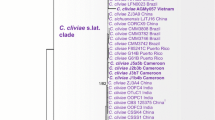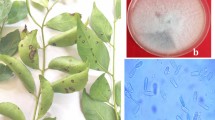Abstract
Rhizoctonia leguminicola, which causes fungal blackpatch disease of legumes and other plants, produces slaframine and swainsonine that are largely responsible for causing salivation, lacrimation, frequent urination, and diarrhea in grazing animals including cattle, sheep, and horses. The original identification of R. leguminicola was based only on morphological characters of the fungal mycelia in cultures because of the lack of fungal genetic markers. Recent investigations suggested that R. leguminicola does not belong to genus Rhizoctonia and is instead a member of the ascomycetes, necessitating an accurate reclassification. The objective of this study was to use both genetic and morphological characters of R. leguminicola to find taxonomic placement of this pathogen within ascomycetes. Internal transcribed spacer region (ITS) and glyceraldehyde-3-phosphate dehydrogenase (gpd) encoding gene were amplified from R. leguminicola isolates by PCR using universal primers and sequencing. Rhizoctonia leguminicola ITS and gpd sequences were aligned with other fungal sequences of close relatives, and phylogenetic trees were constructed using neighbor-joining and parsimony analyses. Rhizoctonia leguminicola isolates were clustered within a clade that contains several genera of ascomycetes belonging to the class dothideomycetes. We suggest that the fungus is misidentified in the genus Rhizoctonia and propose its reclassification in a new genus within the phylum Ascomycota.



Similar content being viewed by others
References
Gough FJ, Elliott ES. Blackpatch of red clover and other legumes caused by Rhizoctonia leguminicola sp. nov. Bull W Va Univ Agric Exp Stn. 1956;387:23.
Anonymous. Blackpatch of clover. Ky Agric Exp Stn Annu Rep. 1933;46:30.
Smith OF. A leaf spot disease of red and white clover. J Agric Res. 1937;54:591–9.
Berkenkamp B. Blackpatch of forage legumes. Can Plant Dis Surv. 1977;57:65–7.
Croom WJ, Hagler J, Froetschel MA. The involvement of slaframine and swainsonine in slobbers syndrome: a review. Anim Sci. 1995;73:1499–508.
De Candolle AP. Mémoire sur le s rhizoctones, noveau genre de champignons qui attaque les racines, des plantes et en particulier celle de la luzerne cultivée. Mem Mus d’Hist Nat. 1815;2:209–16.
Parmeter JR, Whiteny HS. Taxonomy and nomenclature of the perfect state. In: Parmeter JR, editor. Rhizoctonia solani: biology and pathology. Berkeley: University of California Press; 1970. p. 7–19.
Duggar BM. Rhizoctonia crocorum (Pers.) DC. and R. Solani Kuhn (Corticium vagum B. & C.) with notes on other species. Ann Mo Bot Gard. 1915;2:403–58.
MacGinn ME, Lidddl CM, Fernandez-Pavia SP. Rhizoctonia leguminicola and its reclassification as ascomycetes. Phytopathology. 1999;89:551.
White TJ, Bruns T, Lee S, Taylor J. Amplification and direct sequencing of fungal ribosomal RNA genes for phylogenetics. In: Innis MA, Gelfand DH, Sninsky JJ, White TJ, editors. PCR protocols: a guide to methods and applications. New York: Academic Press; 1990. p. 315–22.
Berbee ML, Pirseyedi M, Hubbard S. Cochliobolus phylogenetics and the origin of known, highly virulent pathogens, inferred from ITS and glyceraldehyde 3-phosphate dehydrogenase gene sequences. Mycologia. 1999;91:964–77.
Larkin MA, Blackshields G, Brown NP, Chenna R, McGettigan PA, McWilliam H, Valentin F, Wallace IM, Wilm A, Lopez R, Thompson JD, Gibson TJ, Higgins DG. Clustal W and Clustal X version 2.0. Bioinformatics. 2007;23:2947–8.
Swofford DL. Phylogenetic analysis using parsimony (and other methods). Version 5. Sunderland: Sinauer Associates Inc.; 2002.
Kevin CN. WinClade, version, 2; 1999–2002.
Sneh B, Jabji-Hare S, Neate SM, Diist G. Rhizoctonia species: taxonomy, molecular biology, ecology, pathology and disease control. Norwell: Kluwer academic Publishers; 1995.
Wingfield MJ, Slippers B, Roux J, Wingfield BD. Worldwide movement of exotic forest fungi, especially in the tropics and the Southern Hemisphere. Bioscience. 2001;51:134–40.
Rita AK, Elwin LS, Richard AM. First record and notes on Pleiochaeta setosa in Minnesota. Mycologia. 1991;83(6):826–8.
Radisek S, Leskosek G, Jakse J. Occurrence of Cercospora cantuariensis on hop in Austria and Slovenia. Plant Path. 2009;2009(58):400.
Aust SD, Broquist HP, Rinehart KL Jr. Slaframine. Structural studies of a parasympathomimetic alkaloid of fungal origin. J Am Chem Soc. 1966;88:2879.
Acknowledgments
This work was financially supported by the New Mexico State University Agricultural Experiment Station and the Molecular Biology Graduate Program.
Conflict of interest
The authors declare no conflict of interest.
Author information
Authors and Affiliations
Corresponding author
Rights and permissions
About this article
Cite this article
Alhawatema, M.S., Sanogo, S., Baucom, D.L. et al. A Search for the Phylogenetic Relationship of the Ascomycete Rhizoctonia leguminicola Using Genetic Analysis. Mycopathologia 179, 381–389 (2015). https://doi.org/10.1007/s11046-015-9860-y
Received:
Accepted:
Published:
Issue Date:
DOI: https://doi.org/10.1007/s11046-015-9860-y




